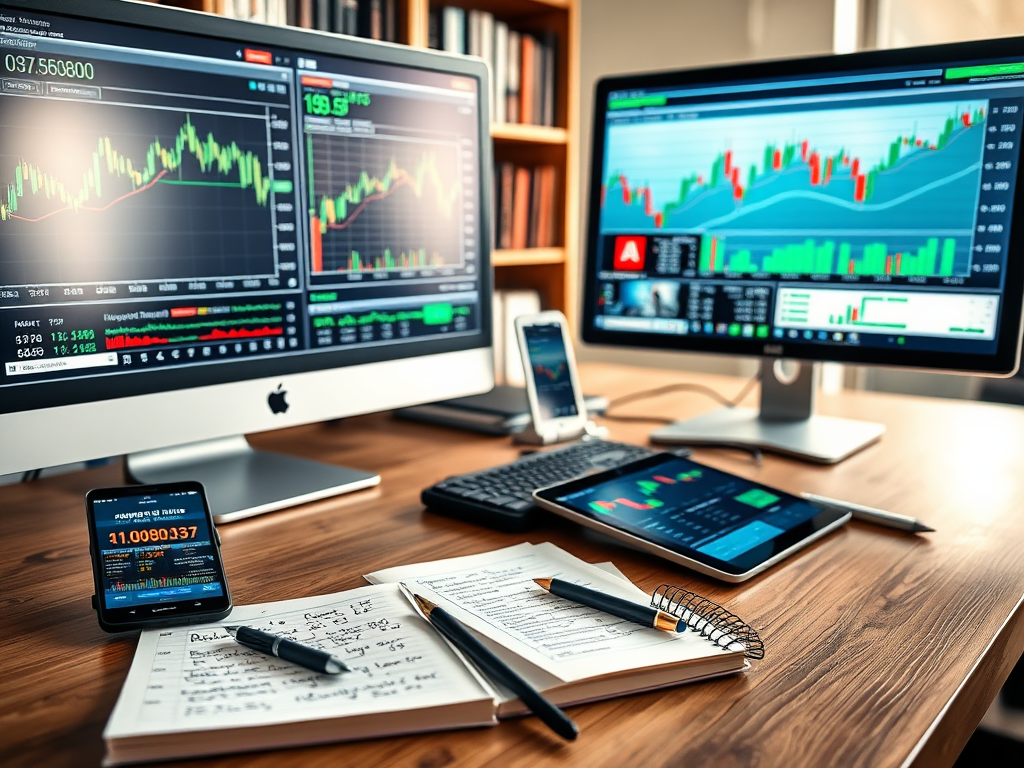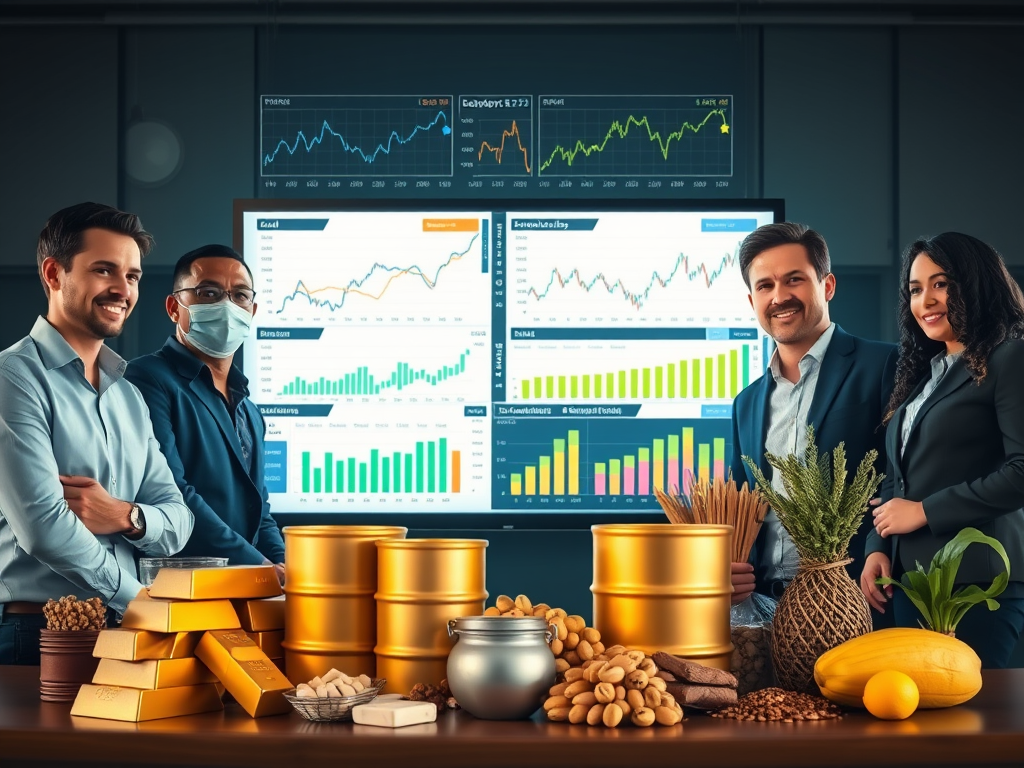How to Start Investing in Commodities: A Beginner’s Roadmap
How to Start Investing in Commodities: A Beginner’s Roadmap
Ever dreamed of diversifying your investment portfolio beyond stocks and bonds? Commodities might just be the golden opportunity you’ve been searching for. 🌾💎🛢️
From precious metals to agricultural products, commodities offer a unique way to hedge against inflation and potentially reap significant returns. But for many beginners, the world of commodity investing can seem as volatile as an oil market in turmoil. Where do you start? How do you navigate the complexities of futures contracts and ETFs?
Fear not, aspiring commodity investor! This comprehensive guide will walk you through the essentials of commodity investing, from understanding the basics to building a robust portfolio. We’ll explore various investment methods, essential tools, and common pitfalls to avoid. By the end, you’ll be equipped with the knowledge to confidently take your first steps into the exciting world of commodity markets. Ready to unlock the potential of this alternative investment class? Let’s dive in!
Understanding Commodities

A. Definition and types of commodities
Commodities are raw materials or primary agricultural products that can be bought and sold. They are categorized into four main types:
- Metals (e.g., gold, silver, copper)
- Energy (e.g., oil, natural gas)
- Livestock and meat
- Agricultural products (e.g., corn, wheat)
These commodities serve as key investment vehicles for portfolio diversification beyond traditional securities. The commodities market operates primarily on supply and demand principles, where disruptions can lead to price volatility.
| Type | Examples | Key Characteristics |
|---|---|---|
| Metals | Gold, silver, copper | Vital for investment and technological applications |
| Energy | Oil, natural gas | Influenced by OPEC production levels and alternative energy advancements |
| Livestock | Cattle, pork | Facing evolving consumer preferences and sustainability concerns |
| Agricultural | Corn, wheat | Shaped by climate change, consumer shifts, and biotechnology |
B. Why invest in commodities
Investors are drawn to commodities for several reasons:
- Portfolio diversification
- Potential to hedge against inflation
- Opportunity for significant returns
Commodities offer a way to diversify beyond traditional stocks and bonds, potentially reducing overall portfolio risk. They can also serve as a hedge against inflation, as commodity prices often rise when the value of currency decreases.
C. Risks and rewards
Investing in commodities comes with both potential rewards and significant risks:
Rewards:
- Portfolio diversification
- Inflation hedging
- Potential for high returns
Risks:
- High volatility
- Sensitivity to unpredictable factors (e.g., weather, diseases, disasters)
- Lack of income generation (unlike stocks that pay dividends)
Factors influencing commodity prices include:
- Production costs
- Currency fluctuations
- Geopolitical stability
- Global economic trends
- Government policies
- Environmental events
It’s important to note that commodities are classified as alternative investments, requiring careful consideration and risk management strategies.
Now that we have covered the fundamentals of understanding commodities, including their definition, types, reasons for investment, and associated risks and rewards, we’ll move on to the next section: “Getting Started with Commodity Investing.” This section will provide practical insights into how beginners can take their first steps in the world of commodity investing.
Getting Started with Commodity Investing

Now that we have covered the basics of understanding commodities, let’s delve into how to get started with commodity investing. This crucial step will set the foundation for your journey into this dynamic market.
A. Assessing your financial goals and risk tolerance
Before diving into commodity investments, it’s essential to evaluate your financial objectives and risk appetite. Commodities are known for their high volatility and sensitivity to various factors like weather, geopolitical events, and global economic trends. Consider the following:
- Short-term vs. long-term goals
- Desired returns
- Ability to withstand market fluctuations
B. Choosing your investment approach
There are several ways to invest in commodities, each with its own risk-reward profile:
| Investment Method | Pros | Cons |
|---|---|---|
| Physical ownership | Direct exposure, tangible asset | Storage, insurance, liquidity challenges |
| Futures contracts | Leverage, direct price exposure | Complex, higher risk |
| Individual securities | Familiar, accessible | Requires industry knowledge |
| ETFs/ETNs/Mutual funds | Diversification, ease of trading | May not track commodity prices directly |
C. Setting a budget for commodity investments
Determine how much capital you’re willing to allocate to commodities. Consider:
- Minimum deposit requirements for different investment types
- Percentage of your overall portfolio dedicated to commodities
- Cash reserves for potential margin calls (if trading futures)
D. Educating yourself on market trends
To succeed in commodity investing, staying informed is crucial. Focus on:
- Supply and demand dynamics
- Global economic developments
- Technological advancements (especially for energy and metals)
- Environmental factors and climate change impacts
- Geopolitical events and policy changes
Remember to regularly review commodity market reports, inventory data, and industry news to make informed decisions.
With this foundation in place, we’ll next explore the different ways to invest in commodities, providing you with a comprehensive understanding of the various investment vehicles available in this exciting market.
Different Ways to Invest in Commodities

Now that we’ve covered the basics of getting started with commodity investing, let’s explore the different ways you can invest in commodities. There are several approaches, each with its own advantages and considerations.
A. Physical ownership of commodities
Physical ownership primarily applies to precious metals like gold and silver. Investors can purchase bullion in the form of coins or bars. However, this method comes with challenges:
- Storage and insurance costs
- Potential liquidity issues
- Limited to certain commodities
B. Commodity futures contracts
Futures contracts allow investors to speculate on commodity prices without owning the physical asset. Key points include:
- Agreements to buy or sell at predetermined prices in the future
- Often settled in cash
- Requires specialized knowledge and higher capital
- Carries significant risk due to price volatility
C. Commodity ETFs and mutual funds
Exchange-Traded Funds (ETFs) and mutual funds offer a more accessible way to invest in commodities:
| Investment Type | Advantages | Considerations |
|---|---|---|
| ETFs | Easy to trade, diversified exposure | May use leverage, amplifying risks |
| Mutual Funds | Professional management, diversification | Higher fees, less trading flexibility |
Both options pool investor capital to invest in various commodity-related assets, including futures and stocks of commodity-producing companies.
D. Stocks of commodity-producing companies
Investing in companies involved in commodity production or processing offers indirect exposure to the commodity market:
- Accessible through standard brokerage accounts
- Requires industry-specific knowledge
- Less volatile than direct commodity investments
- Potential for dividend income
E. Commodity-linked structured products
These complex financial instruments provide exposure to commodities through various mechanisms:
- Exchange-Traded Notes (ETNs)
- Structured bonds
- May offer unique payoff structures or protection features
Each investment method carries its own risk profile and requires careful consideration. As we move forward to building your commodity portfolio, it’s crucial to understand how these different investment vehicles can work together to achieve your financial goals.
Building Your Commodity Portfolio

Now that we’ve explored different ways to invest in commodities, let’s focus on building a robust commodity portfolio. This crucial step will help you maximize potential returns while managing risks effectively.
A. Diversification strategies
Diversification is key to building a resilient commodity portfolio. By spreading your investments across various commodities and sectors, you can potentially enhance returns while minimizing risk. Here are some effective diversification strategies:
- Cross-sector allocation: Invest in commodities from different sectors (e.g., energy, metals, agriculture)
- Geographic diversification: Consider commodities produced in various regions to mitigate local market risks
- Correlation analysis: Include commodities with low correlation to each other and to traditional assets
A strategic allocation of 2% to 5% to commodities could enhance portfolio returns with minimal risk, especially in the context of increasing inflation concerns.
B. Balancing commodities with other asset classes
To achieve optimal portfolio performance, it’s essential to balance your commodity investments with other asset classes. Here’s a comparison of commodities with traditional assets:
| Asset Class | Correlation with Commodities | Benefits |
|---|---|---|
| Equities | Moderate | Growth potential, dividend income |
| Fixed Income | Low to Moderate | Stability, regular income |
| Real Estate | Low to Moderate | Tangible asset, potential hedge against inflation |
Commodities can serve as both defensive and offensive diversifiers, particularly during inflationary periods or when traditional stocks and bonds decline.
C. Regular portfolio review and rebalancing
To maintain the effectiveness of your commodity portfolio, regular review and rebalancing are crucial. Consider the following:
- Monitor market conditions: Stay informed about supply-and-demand dynamics affecting commodity prices
- Assess performance: Evaluate the performance of individual commodities and your overall portfolio
- Rebalance periodically: Adjust your allocations to maintain your desired risk-return profile
- Consider long-term trends: Factor in emerging trends, such as the shift towards renewable energy infrastructure
Remember that volatility in commodities can actually enhance portfolio performance by facilitating buy-low and sell-high opportunities during rebalancing.
With your commodity portfolio now structured, it’s time to explore the essential tools and resources that will help you navigate the complex world of commodity investing. These resources will be crucial in making informed decisions and staying ahead in the dynamic commodity markets.
Essential Tools and Resources for Commodity Investors

Now that we’ve covered building your commodity portfolio, let’s explore the essential tools and resources that can help you make informed investment decisions.
A. Market analysis platforms
Several platforms offer comprehensive market analysis for commodity investors:
-
Vesper: Emerging leader in commodity intelligence, providing global data and insights across various commodities.
- Pros: Extensive multi-commodity coverage, rapid growth
- Cons: Subscription-based model, unequal depth of insights across commodities
-
Bloomberg: Offers a 360-degree view of commodity markets with timely updates.
- Pros: Comprehensive coverage, real-time information
- Cons: Requires subscription, can be overwhelming for beginners
-
Trading Economics: Provides access to historical data and forecasts with customizable dashboards.
- Pros: Vast array of data, customizable interface
- Cons: Subscription model, complex for new users
| Platform | Strengths | Weaknesses |
|---|---|---|
| Vesper | Multi-commodity coverage | Unequal depth of insights |
| Bloomberg | Comprehensive, real-time | Subscription required |
| Trading Economics | Customizable, historical data | Complex for beginners |
B. Financial news sources
Staying informed about market trends is crucial for commodity investors. Here are some reliable sources:
- Reuters: Trusted source for timely news and market data across commodities.
- S&P Global Platts: Focuses on energy commodities, offering detailed insights.
- OPEC’s Monthly Oil Market Report: Specializes in oil sector insights with timely updates and expert analysis.
C. Commodity price tracking apps
To monitor commodity prices on-the-go, consider these resources:
- World Bank’s Commodities Price Data tool: Delivers extensive global price data.
- CME Group: Serves as a trading platform for futures and options related to commodities.
D. Professional advisors and brokers
For personalized guidance, consider:
- Financial advisors specializing in commodity investments
- Reputable brokerage firms with expertise in commodity trading
Remember, while these tools and resources are valuable, they each have their strengths and limitations. It’s essential to use them in combination to get a comprehensive view of the commodity market.
With these essential tools and resources at your disposal, you’ll be better equipped to navigate the complex world of commodity investing. In the next section, we’ll explore common pitfalls in commodity investing and how to avoid them, ensuring you’re well-prepared for the challenges ahead.
Navigating Common Pitfalls in Commodity Investing

Now that we’ve explored the essential tools and resources for commodity investors, let’s delve into navigating common pitfalls in commodity investing. Armed with knowledge and resources, it’s crucial to understand and avoid potential risks that can significantly impact your investment journey.
A. Avoiding over-concentration in a single commodity
One of the primary risks in commodity investing is over-concentrating your portfolio in a single commodity. This can expose you to significant price volatility and potential losses. To mitigate this risk:
- Diversify your commodity investments across different sectors (e.g., agriculture, energy, precious metals)
- Consider using commodity ETFs or mutual funds that offer exposure to a basket of commodities
- Regularly rebalance your portfolio to maintain a balanced allocation
B. Managing leverage and margin calls
Commodity futures trading often involves high leverage, which can lead to substantial gains but also significant losses. To navigate this pitfall:
- Understand the leverage ratios in commodity trading (typically 5% to 15% of contract value)
- Be aware that small price movements can result in large profits or losses
- Set strict risk management rules and adhere to them
- Consider using Commodity Trading Advisors (CTAs) for professional management
| Leverage Ratio | Potential Impact |
|---|---|
| 5% | 20x leverage |
| 10% | 10x leverage |
| 15% | 6.67x leverage |
C. Understanding storage and delivery costs
When investing in physical commodities or futures contracts, it’s essential to factor in storage and delivery costs:
- Research the costs associated with storing physical commodities
- Consider the impact of “contango” and “backwardation” on futures contracts
- Be aware of potential delivery obligations when trading futures
D. Dealing with market volatility
Commodities are known for their high volatility compared to other asset classes. To navigate this challenge:
- Recognize that commodity prices can fluctuate dramatically (halving or tripling in short periods)
- Compare commodity volatility to other assets (e.g., daily price movements in natural gas can exceed 30% compared to less than 1% for currencies)
- Implement risk management strategies such as stop-loss orders and position sizing
- Stay informed about factors influencing commodity prices, including:
- Political actions (e.g., tariffs)
- Seasonal changes
- Weather conditions
- Technological advancements
By understanding and preparing for these common pitfalls, you can better position yourself to navigate the complex world of commodity investing and potentially capitalize on the opportunities it presents.

Investing in commodities offers a unique opportunity to diversify your portfolio and potentially hedge against inflation. As we’ve explored, there are various ways to enter this market, from physical ownership and futures contracts to exchange-traded products and individual securities. Each method comes with its own set of advantages and risks, making it crucial to understand the landscape before diving in.
Remember, while commodities can provide significant returns, they also come with high volatility and external risks. As you embark on your commodity investing journey, start small, continually educate yourself, and consider seeking advice from financial professionals. By leveraging the tools and resources available and staying informed about market trends, you can navigate the complex world of commodities and work towards achieving your investment goals.
